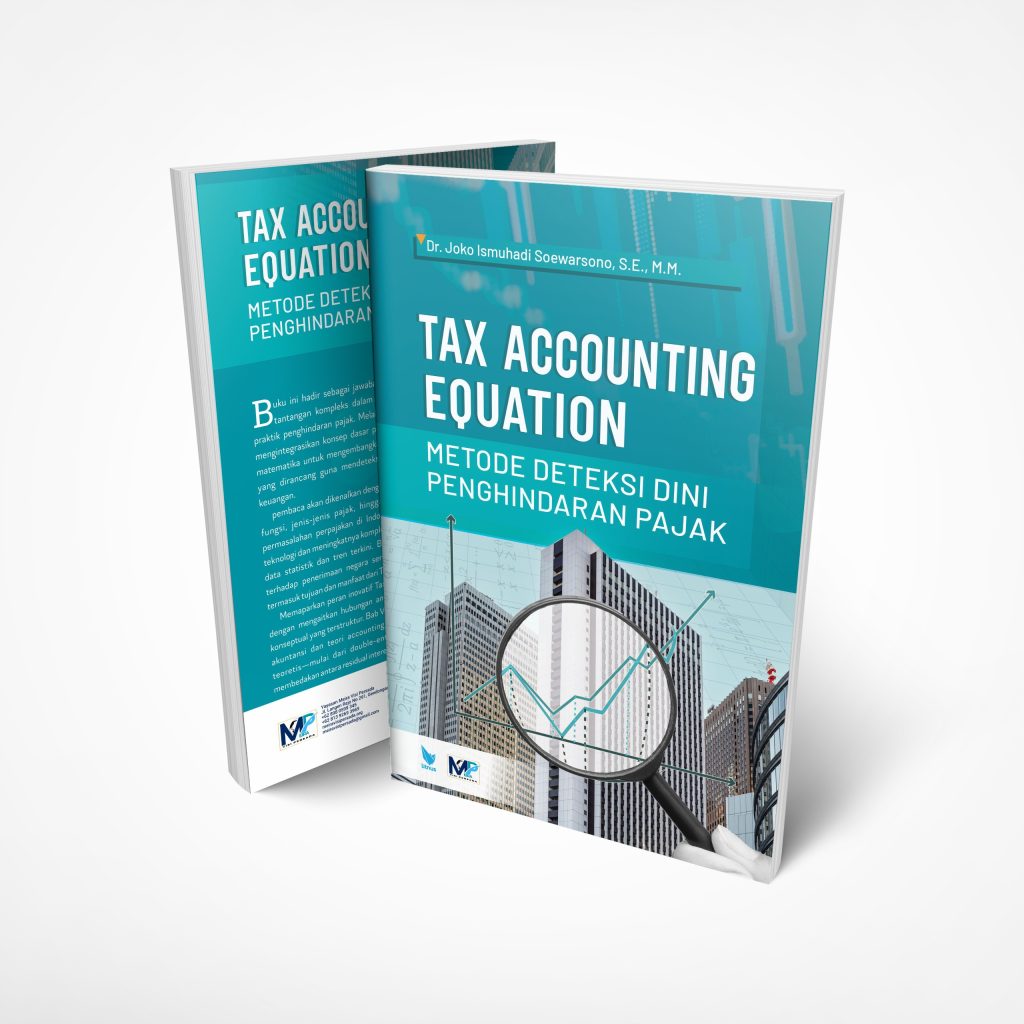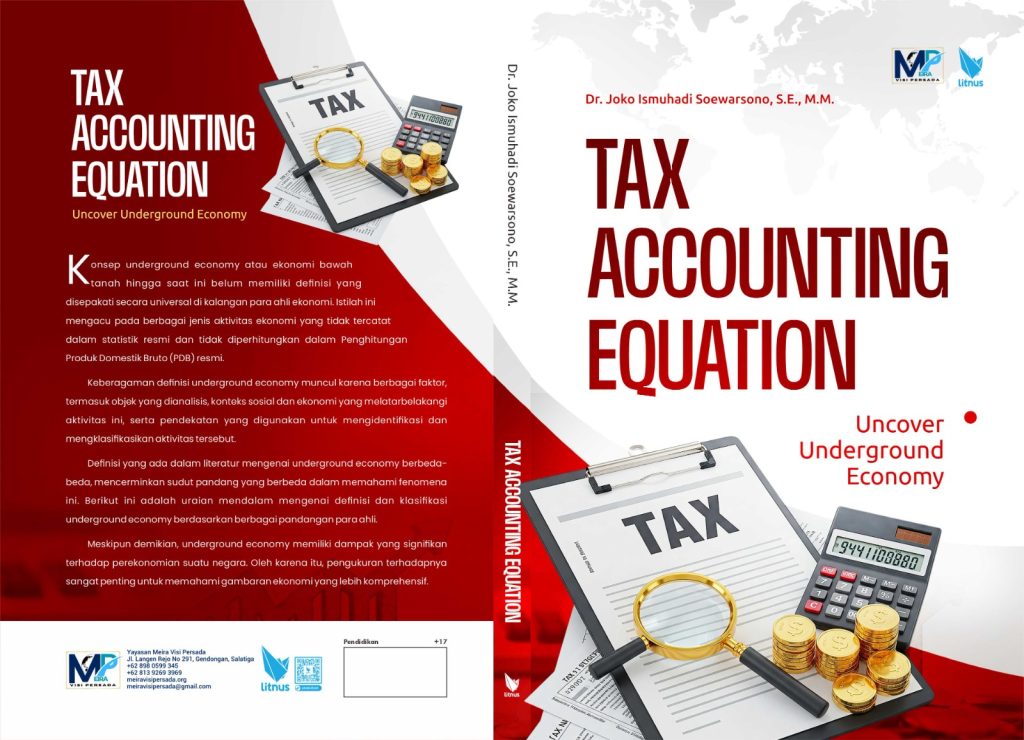
The Integrated Digital Tax Administration System in Indonesia: Enhancing Compliance through the Tax Accounting Equation, Self-Assessment Monitoring, and the Tri Hita Karana Philosophy
- Ekonomi
Monday, 14 July 2025 12:47 WIB
Jakarta, fiskusnews.com:
1. Introduction: Modernizing Indonesia’s Tax Administration Landscape
Indonesia’s tax system has historically contended with significant challenges, including pervasive inefficiencies, a reliance on outdated manual processes, and a persistently low tax-to-GDP ratio. In 2022, this ratio stood at merely 12%, a figure notably below global benchmarks, which has historically impeded effective tax collection and complicated business operations within the country. Further underscoring the urgency for comprehensive reform, a 2020 survey involving 69 countries positioned Indonesia’s tax administration system as the 26th most complex worldwide. Despite these systemic hurdles, the Directorate General of Taxes (DGT) has consistently striven to optimize tax services and encourage taxpayers to fulfill their obligations. Operating within a self-assessment framework, taxpayers are primarily entrusted with the responsibility of calculating, paying, and reporting their own taxes. To bolster compliance, the DGT strategically targets high-risk taxpayers for audits.
In response to these enduring challenges, the Indonesian government has embarked on a profound modernization initiative with the launch of the Core Tax Administration System (CTAS), also referred to as the Core Tax System (CTS), in January 2025. This digital platform is designed to fundamentally overhaul and replace antiquated manual procedures, centralize disparate data sources, automate a wide array of services, and establish a cohesive, integrated taxation ecosystem. The strategic objectives of CTAS are manifold: to achieve greater efficiency, enhance transparency, improve overall compliance, enable the formulation of smarter tax policies, and streamline digital tax processes. This modernization is anticipated to render tax reporting more manageable, faster, and more transparent, fostering a renewed sense of optimism among businesses. The persistent low tax-to-GDP ratio and the identified complexity of the tax administration system underscore that the CTAS initiative is not merely an incremental technological upgrade but a fundamental, strategic imperative for the Indonesian government. This signifies a recognition that traditional, often fear-based enforcement methods, such as sanctions, investigations, or “hostage-taking” as described by a tax consultant, Mr. Damar , have proven insufficient for achieving sustainable compliance. The explicit benefits of CTAS—”Greater Efficiency,” “More Transparency,” and “Improved Compliance” —directly align with the need for “voluntary obedience” that Mr. Damar advocates. This alignment suggests a deeper policy objective: to fundamentally shift the taxpayer-DGT relationship from one primarily based on coercion to one built on trust and ease of compliance. The ultimate success of CTAS is thus intrinsically linked to its ability to foster this behavioral transformation.
Central to this digital transformation are the Tax Accounting Equation (TAE) and the Self-Assessment Monitoring System (SAMS). The Tax Accounting Equation (TAE), a pioneering concept introduced by Indonesian tax specialist Dr. Joko Ismuhadi, functions as a forensic accounting tool specifically developed to detect complex financial irregularities and sophisticated tax evasion methods prevalent in Indonesia. Complementing TAE is the Self-Assessment Monitoring System (SAMS), a proactive monitoring framework that harnesses advanced technology, data analytics, and Artificial Intelligence/Machine Learning (AI/ML) to enable continuous risk monitoring and the early detection of non-compliance. The synergistic integration of TAE and SAMS within the broader CTAS framework is projected to yield substantial benefits, including significant improvements in taxpayer compliance, notable enhancements in administrative efficiency, accelerated tax revenue collection, a direct increase in the national tax ratio, and a substantial reduction in costly tax disputes.
A distinctive and culturally significant aspect influencing this modernization effort is the Tri Hita Karana (THK) philosophy. This traditional Balinese wisdom emphasizes the critical importance of balance across three fundamental relationships: Parahyangan (harmony between humans and God), Pawongan (harmony among human beings), and Palemahan (harmony between humans and the natural environment). Within the tax context, THK proposes a compliance model that transcends mere legal obligation, advocating for tax payments as a means of fostering shared welfare, embodying devotion to God, and demonstrating concern for fellow human beings and the environment. This perspective, deeply aligned with Hindu teachings, aims to cultivate voluntary obedience rather than compliance driven solely by fear of penalties. The trust deficit, exacerbated by instances of corruption among tax officials and the perceived impunity that has followed, as highlighted by Mr. Reno’s testimony , along with the observation that repeated tax amnesties further undermine public trust , represents a critical barrier to achieving “voluntary obedience.” Tri Hita Karana, particularly its Pawongan (relationship among people) and Parahyangan (relationship with God) principles, offers a culturally resonant framework to address this challenge. By framing tax payments as a moral and societal duty towards collective well-being, it provides a powerful counter-narrative to the prevailing distrust. For CTAS to truly enhance compliance integrity, it cannot rely solely on technological efficiency; the DGT must actively integrate THK’s principles into its operational ethos and public communication strategies. This integration necessitates not only ensuring transparency in automated systems but also visibly demonstrating accountability and integrity among tax officials. The philosophical foundation of THK, therefore, serves as a crucial strategic enabler for rebuilding trust, transforming taxation from a mere transaction into a civic and ethical contribution to national prosperity.
2. Core Components of Indonesia’s Digital Tax Ecosystem
2.1. The Core Tax Administration System (CTAS): A Centralized Platform
The Core Tax Administration System (CTAS), which commenced operations in January 2025, is engineered to streamline a comprehensive array of essential tax operations. These include taxpayer registration, the entire tax return filing process, efficient payment processing, continuous compliance tracking, and the execution of audits. Its core features encompass online tax reporting and payment capabilities, a real-time taxpayer database for up-to-date information, automated compliance checks to identify deviations, and enhanced data security protocols to protect sensitive information. A critical aspect of its design is deep integration with banks and other financial institutions, facilitating seamless data flow and payment processes.
Each taxpayer is provided with a unique DGT-issued account for managing their tax records and filings online. Activation of this account is mandatory, requiring email/phone verification and an Electronic Filing Identification Number (EFIN) to access the DGT’s online platforms. To promote digitalization, manual filing is largely phased out, permitted only in exceptional circumstances such as technical issues or emergencies. CTAS represents a consolidation of various existing tax-related applications, including e-Bupot, e-Faktur, and DJP Online, into a single, unified platform, aiming to reduce fragmentation and improve user experience. It also introduces a dedicated menu for centralized tax documents, such as Tax Collection Letters (STP), Tax Assessment Notices (SKP), Tax Compliance Inquiry Letters (SP2DK), and official tax announcements. An integrated notification system is also in place to alert taxpayers about reporting, settlement, and response deadlines.
The CTAS is not merely an incremental upgrade but a foundational shift, redefining tax administration in Indonesia. The comprehensive nature of its features and their interconnectedness signify a complete re-architecture of the tax administration system. The explicit goal to “replace outdated manual procedures” and “eliminate manual processes” indicates a move beyond simple digitization, which would only make existing paper-based processes electronic. Instead, CTAS aims for a true digital transformation, fundamentally re-engineering the entire workflow of tax administration. This holistic approach is designed to foster greater efficiency by automating manual processes, which is expected to significantly reduce human errors and streamline overall tax management. Real-time tracking of tax payments is designed to foster greater trust between businesses and regulatory authorities, while simultaneously enhancing financial oversight and compliance by providing clear visibility into tax transactions. Automated reminders are anticipated to play a crucial role in minimizing missed deadlines and the imposition of penalties, thereby improving overall compliance. The digitization of tax services, as embodied by CTAS, is projected to have a significant positive influence on taxpayer compliance by making tax obligations easier to fulfill. Ultimately, CTAS is envisioned to optimize state revenue collection while simultaneously facilitating taxpayers in efficiently fulfilling their obligations.
2.2. The Tax Accounting Equation (TAE): A Forensic Tool for Anomaly Detection
The Tax Accounting Equation (TAE) was developed by Indonesian tax specialist Dr. Joko Ismuhadi in response to the growing complexities of tax compliance and the pressing need for advanced methods to detect financial irregularities. TAE is presented in two interrelated forms: Revenue - Expenses = Assets - Liabilities and Revenue = Expenses + Assets - Liabilities. These formulations represent a strategic rearrangement of the fundamental basic accounting equation (Assets = Liabilities + Equity). The deliberate emphasis is placed on revenue, recognizing its critical role as an indicator of a company’s economic activity and its corresponding tax obligations. The core mathematical principle of TAE is to establish an expected equilibrium between key financial reporting components. By mathematically linking revenue, expenses, assets, and liabilities, TAE provides a robust framework for both tax authorities and organizations to quantitatively assess financial statements. For specific and more complex scenarios, particularly where taxable income might be intentionally reported as zero or negative to minimize tax liabilities, Dr. Ismuhadi also formulated the Mathematical Accounting Equation (MAE) as: Assets + Dividen + Beban = Kewajiban + Ekuitas + Pendapatan.
TAE is specifically designed to uncover inconsistencies within financial statements that might not be readily apparent through traditional financial analysis or conventional auditing procedures. Its design is tailored to the specific challenges and characteristics of the Indonesian economy, including the prevalence of the underground economy and various tax evasion tactics. This includes detecting inconsistencies between a company’s reported profitability and its net worth, and identifying deceptive practices such as the use of clearing accounts to temporarily misrecord revenues as liabilities or expenses as assets. The explicit statements that TAE targets “often concealed and intricate methods employed in sophisticated tax evasion” and “underreporting income” highlight its specialized nature. The focus on “specific financial reporting patterns and manipulations commonly observed in Indonesia,” such as inconsistencies between reported profitability and net worth, or the use of clearing accounts to misrecord revenues or expenses , indicates that TAE is not a generic accounting tool but a highly specialized, forensic instrument. It was developed with a deep understanding of local evasion tactics and the “underground economy”. This targeted approach signifies a move towards more precise and effective tax enforcement, complementing the broader digital transformation. By leveraging the data infrastructure and analytical capabilities of CTAS, TAE can function as a powerful tool for real-time monitoring and risk assessment, ultimately contributing to increased tax revenue and more accurate tax deposits.
2.3. Self-Assessment Monitoring System (SAMS): Principles of Proactive Compliance
The Self-Assessment Monitoring System (SAMS) incorporates advanced technology-enabled solutions, including automation, sophisticated data insights, and Artificial Intelligence (AI) to facilitate continuous risk monitoring. It involves an ongoing process of observing and analyzing various risk factors to detect and address potential problems at an early stage. The system utilizes automated processes to continuously track and report on identified risk factors, while employing data analytics to discern trends and pinpoint potential risks. The integration of AI/Machine Learning (ML) and real-time data analysis within SAMS empowers tax authorities to identify potential non-compliance as it occurs or even before formal reporting deadlines, thus moving beyond the traditional reactive approach of waiting for annual returns and initiating time-consuming audits. Globally, tax administrations are increasingly investing in real-time transaction monitoring, AI-driven anomaly detection, and automated tax validation systems to enhance compliance.
A primary role of SAMS is to proactively identify and manage potential compliance risks, mitigating issues before they escalate and safeguarding an organization’s reputation and financial stability. Key benefits derived from SAMS include improved risk management, enhanced decision-making through valuable insights, and optimized resource allocation by focusing efforts on areas with the highest risk. Effective compliance monitoring, as facilitated by SAMS, extends beyond merely avoiding penalties; it actively contributes to building a responsible and ethical operational environment within businesses. Proactive compliance plans, which SAMS supports, involve systematic strategies such as regular updates on tax laws, periodic risk assessments, and comprehensive staff training programs to reduce the risk of penalties. Automated tax compliance engines, which are integral to SAMS, play a crucial role in preventing costly errors and penalties by automating tax rate updates and compliance rule management, thereby eliminating the need for error-prone manual lookups. Furthermore, AI-driven payroll compliance tools enhance this preventative capability by detecting potential tax filing discrepancies and identifying potential worker misclassifications before submissions are made to regulatory agencies. The adoption of these AI-powered solutions has led to a substantial reduction in tax penalties, with organizations reporting an average of 50% decrease in these avoidable costs. They also contribute to faster dispute resolution by providing detailed audit trails and analytical insights, which facilitate more efficient communication with regulatory agencies and accelerate the resolution process.
3. Integration Mechanism: TAE, SAMS, and CTAS in Action
The integration of the Tax Accounting Equation (TAE) and the Self-Assessment Monitoring System (SAMS) within the Core Tax Administration System (CTAS) is designed to create a smarter and more responsive tax administration system in Indonesia. This synergy aims to enhance taxpayer compliance, improve administrative efficiency, accelerate tax revenue collection, increase the national tax ratio, and significantly reduce costly tax disputes.
3.1. Data Retrieval and Harmonization
The efficacy of the TAE-SAMS integration is critically dependent on the quality, standardization, and real-time accessibility of the underlying accounting data. SAMS will access taxpayer accounting data relevant to the Tax Accounting Equation, which can include data directly from the taxpayer’s accounting system (if integrated), financial statements such as the Balance Sheet, Income Statement, and Cash Flow Statement, or other data necessary for forming the tax accounting equation (e.g., Revenue – Expenses = Taxable Profit). This process requires robust data integration capabilities to pull and harmonize data from diverse internal and external sources. The system will leverage detailed financial data, ideally captured through advanced systems like triple-entry accounting, to ensure comprehensiveness and verifiability.
A significant challenge in this process is the growing volume of tax data, often characterized by segregated views, limited trust in enterprise data sources, and an inability to reconcile master data gaps prior to tax filings. Governments, including Indonesia, also grapple with the rapid growth in data volume required for reporting, much of which remains trapped in spreadsheets or other applications that are not easily accessible or integrated. Indonesia’s own experience highlights challenges with different data architectures for various tax types, which can complicate data analysis. Inaccurate, fragmented, or non-standardized data would severely undermine the analytical power of TAE and the predictive capabilities of SAMS, potentially leading to a high rate of false positives (incorrectly identified discrepancies) or, more critically, missed discrepancies (undetected non-compliance). This emphasizes that robust data governance and interoperability are foundational requirements, not merely desirable features.
The integration of TAE and SAMS within CTAS represents a shift towards a data-driven tax administration. The ability to automatically analyze taxpayer accounting data to detect anomalies indicative of potential tax under-reporting is a key benefit. This capability is built upon the DGT’s strategic initiative to utilize data analytics for sustainable tax compliance and to minimize tax gaps. Analytics are employed across various tax administration functions, including taxpayer registration, compliance monitoring, dispute resolution, and law enforcement. The DGT uses internal data, such as “e-Faktur” data from its tax invoice application system, to determine the focus of analysis, often by sector. This data, which includes taxpayer identification numbers (TIN), names, addresses, VAT paid amounts, and descriptions of goods/services, is used for diagnostic analytics (e.g., recapitulation and comparison with VAT and income tax returns) and predictive analytics (e.g., time series analysis to forecast taxable deliveries). The DGT also performs supply chain analysis to benchmark prices and determine distribution layers.
3.2. Automated Discrepancy Flagging
The CTAS is equipped with automated compliance checks and real-time taxpayer databases. This allows for the automatic analysis of taxpayer accounting data to detect anomalies indicative of potential tax under-reporting. The system leverages AI-driven anomaly detection and real-time transaction monitoring to flag suspicious activities. This proactive approach helps identify non-compliance as it happens, or even before formal reporting deadlines, moving beyond traditional reactive audits.
The DGT’s compliance risk management (CRM) system uses data matching to identify potential non-compliance. This involves comparing taxpayer income reports with internal systems (like Approweb Information System – AIS) and external data sources such as banks, customs, insurance transactions, and other data. When discrepancies are identified, the system flags the taxpayer, which can lead to the issuance of a Surat Permintaan Penjelasan atas Data dan/atau Keterangan (SP2DK), or “Letter of Request for Explanation of Data and/or Information”. The SP2DK is a preliminary step in the tax supervision process, allowing the DGT to seek clarification without immediately resorting to a full tax audit. It is based on legal regulations such as Ministry of Finance Regulation (PMK) 17/PMK/03/2013 and PMK No. 79 Year 2023, which enhance efficiency and effectiveness.
Common triggers for an SP2DK include discrepancies in reported income, unreported assets, unexplained capital injections (based on third-party reports), missing information in tax filings, or a history of non-compliance. The system’s ability to automatically identify mismatches saves tax practitioners countless hours of manual work and helps prevent audits by allowing corrective action to be taken in advance. This real-time flagging and automated analysis contribute to a significant reduction in errors and improved compliance rates.
3.3. Production of Recommended Tax Deposits (Apelle Tax Deposit)
While the term “Apelle Tax Deposit” is used in the query, the research materials refer to “tax deposits” as pre-paid tax amounts not yet assigned to a specific payment. The CTAS includes functionalities for “Tax Deposits & Payments”. Taxpayers can use these deposits for direct payments, fund transfers, or to cover overpayments. The system’s ability to automatically flag high discrepancies is intended to lead to the production of recommended tax deposits, which would function as a proactive measure to guide taxpayers toward correct obligations and avoid penalties.
When high discrepancies are flagged by the integrated TAE and SAMS within CTAS, the system can generate a recommended tax deposit amount. This is a logical extension of automated compliance checks and real-time data analysis, which identify potential under-reporting. The DGT’s digital transformation efforts aim to centralize data and automate services, making it easier for taxpayers to fulfill their obligations. The CTAS provides a “Taxpayer Account System” where taxpayers can manage their records and filings online. This account would be the logical channel for communicating such recommended deposits.
The process of generating recommended tax deposits is implicitly linked to the DGT’s broader shift towards proactive compliance monitoring and the use of data analytics to identify potential unmet tax obligations. By identifying discrepancies early, the system can calculate an advised amount that, if paid, would bring the taxpayer into compliance, thereby avoiding the issuance of a Tax Collection Letter (STP) or a Tax Assessment Letter (SKP) which carry administrative sanctions. This proactive approach aligns with the objective of reducing costly tax disputes and enhancing overall compliance.
3.4. Notification Protocols and Taxpayer Response
The DGT utilizes electronic channels for sending decisions and documents to taxpayers, primarily through their registered CTAS account or email. This integrated notification system within CoreTax ensures taxpayers are alerted to tax reporting, settlement, and response deadlines, enabling proactive compliance management. The transmission date of these electronic documents serves as the official receipt date for the taxpayer.
When a discrepancy is identified, an SP2DK is typically issued. This letter is an official request from the DGT for clarification on potential issues with tax returns, such as discrepancies in reported income, unreported assets, or unexplained capital injections. Taxpayers are generally given 14 working days to respond to an SP2DK, either directly, in writing, or through audiovisual media. A prompt and comprehensive response, supported by accurate documentation, is crucial to prevent escalation to a full tax audit or the issuance of a tax assessment letter.
The DGT’s CRM system flags taxpayers based on compliance alerts, but receiving an SP2DK does not automatically categorize a taxpayer as non-compliant; it is a preliminary estimate requiring further information. Taxpayers are encouraged to respond positively to minimize disputes. If a taxpayer agrees with the discrepancy outlined in an SP2DK, they can make a voluntary payment of the underpaid taxes and amend their Tax Return. This voluntary compliance is a key objective, as it allows taxpayers to correct errors under more favorable terms, potentially avoiding penalties. The DGT’s past Voluntary Disclosure Program (VDP) aimed to encourage self-assessment and correction of past tax obligations, with a clear message that post-VDP, enforcement would be enhanced based on better data.
If a taxpayer fails to adequately respond to an SP2DK, or if the issues remain unresolved, consequences can include the issuance of a Tax Assessment Letter (SKP), the initiation of a tax audit, or potential penalties and fines. The DGT has the authority to issue Tax Collection Letters (STP) for unpaid or underpaid income tax, insufficient payments due to miscalculations, or administrative sanctions. Taxpayers can object to an STP by requesting a reduction, write-off, or cancellation.
4. Enhancing Taxpayer Compliance and Avoiding Penalties
The integration of TAE and SAMS within CTAS is fundamentally aimed at enhancing taxpayer compliance integrity and helping taxpayers avoid penalties. This is achieved through a multi-pronged approach that combines proactive detection, streamlined processes, and a shift towards voluntary compliance.
4.1. Proactive Compliance Monitoring and Risk Mitigation
The CTAS, with its automated compliance checks and real-time taxpayer database, enables proactive compliance monitoring. This system is designed to identify potential tax under-reporting through the automatic analysis of taxpayer accounting data. SAMS, as a continuous risk monitoring system, leverages AI/ML and data analytics to detect non-compliance as it happens or even before formal reporting deadlines, moving beyond traditional reactive audits. This proactive approach is crucial in mitigating issues before they escalate, safeguarding businesses from penalties and reputational damage.
Automated systems, like those integrated into CTAS, reduce human error significantly, which is a common trigger for audits and penalties. For instance, automated tax compliance engines prevent costly errors by automating tax rate updates and compliance rule management, eliminating manual lookups prone to miscalculations. AI-driven tools can also detect potential tax filing discrepancies and worker misclassifications before submissions, further preventing costly mistakes and ensuring greater accuracy. This proactive identification of issues allows taxpayers to take corrective action in advance, potentially preventing penalties and interest.
4.2. Streamlined Processes and Reduced Compliance Burden
The CTAS aims to simplify tax management by integrating all tax-related data into a single system, thereby enhancing efficiency and reducing errors. Automating core tax processes, such as tax calculation and reporting, reduces manual effort and time, allowing businesses to meet obligations quickly and efficiently. This streamlining is a key component of reducing the overall compliance burden on taxpayers.
The DGT’s efforts to digitalize tax services, including online reporting and payment, are intended to make it easier and more convenient for taxpayers to fulfill their obligations. Features like automated reminders play a crucial role in ensuring timely tax filings, minimizing the risk of missed deadlines and associated penalties. By reducing the time and effort taxpayers spend on record-keeping, form-filling, and tax calculation, the system frees up resources for more productive activities, particularly for small businesses. This also helps reduce mistakes that can occur when taxpayers manually sort through information.
4.3. Fostering Voluntary Compliance and Trust
Indonesia operates under a self-assessment tax system, where taxpayer compliance is paramount. The CTAS, through its enhanced transparency and real-time tracking of tax payments, aims to foster trust between businesses and regulatory authorities. Accurate and reliable tax data, facilitated by the new system, is crucial for informed decision-making and the development of fairer tax policies, which in turn benefits businesses by creating a more predictable and equitable regulatory environment.
The DGT’s strategies for building transparency and trust in automated tax systems include investing in digital infrastructure and human capital, developing AI governance and accountability guidelines, and building transparency into AI systems. Elevating the status of the DGT to be more autonomous and accountable is also seen as a step towards a future-ready tax system that fosters better governance and public trust.
The philosophical underpinnings of Tri Hita Karana, which emphasize harmony and shared welfare, are particularly relevant here. Framing tax payments as a form of devotion and concern for society and the environment, rather than a mere obligation, can cultivate voluntary obedience. This approach is vital given that taxpayer trust has been eroded by past corruption cases involving tax officials and the perception that taxes paid are not always used properly. Repeated tax amnesties have also been observed to normalize non-compliance and further erode public trust. By aligning the digital tax system with these cultural values, the DGT can work to rebuild trust and encourage a more intrinsic motivation for compliance.
5. Challenges and Considerations
While the integration of TAE and SAMS within CTAS offers substantial benefits, several challenges and considerations need careful management to ensure successful implementation and sustained impact.
5.1. Data Quality and Interoperability
The effectiveness of TAE and SAMS is critically dependent on the quality, standardization, and real-time accessibility of underlying accounting data. Inaccurate, fragmented, or non-standardized data can severely undermine the analytical power of TAE and the predictive capabilities of SAMS, potentially leading to a high rate of false positives or missed discrepancies. Indonesia’s experience with different data architectures for various tax types further complicates data analysis. Robust data governance and interoperability are therefore foundational requirements.
The DGT faces a “last-mile problem” where centrally generated data from analytics systems is not immediately actionable for tax officers, necessitating them to develop their own data pipelines for further processing. Addressing this requires enhancing taxpayer profile data by integrating comprehensive analytics outcomes, including compliance risk profiling, directly into operational system data through a “reverse-ETL” approach. Flexible self-service analytics platforms are also needed for complex scenarios.
5.2. Legal and Ethical Frameworks for Automated Systems
The deployment of AI and automated systems in tax administration raises significant legal and ethical challenges. Data privacy is a major concern, as AI systems handle highly sensitive taxpayer information, making it difficult to comply with stringent privacy laws given the vast amounts of data involved. There is also a risk of biases present in historical data leading to unfair treatment of certain taxpayers.
To address these, it is essential to incorporate AI-specific provisions within the tax code that align with data protection regulations. Clear lines of accountability must be established for decisions made by AI systems to eliminate legal ambiguity and ensure transparency. Robust audit mechanisms are also necessary to regularly evaluate AI models, enabling the identification and mitigation of bias or discriminatory outcomes.
5.3. Taxpayer Trust and Education
Building public trust in AI-driven processes is a significant barrier. Lack of trust often stems from taxpayers’ skepticism about AI decisions. The DGT’s general goals for AI in taxation include fostering transparency, fairness, and citizen-centric governance. This requires elevating the DGT’s status to be more autonomous, accountable, and innovative, enabling it to adopt transformative tools like AI with the necessary agility.
Personalizing taxpayer education and reminders is an opportunity for AI adoption. The DGT’s 2024 compliance improvement plan (CIP) includes goals to boost voluntary compliance, educate taxpayers with relevant knowledge, foster a more positive perception, and advance taxpayer trust in the DGT. This involves a customer-centric approach based on user experience, an open and integrated system, and data and knowledge-driven processes. Taxpayers need to activate and learn the new CTAS, and finance teams require proper training to prevent errors and ensure accurate tax filings.
6. Conclusion and Recommendations
The integration of the Tax Accounting Equation (TAE) and a Self-Assessment Monitoring System (SAMS) within Indonesia’s Core Tax Administration System (CTAS) represents a transformative leap towards a more efficient, transparent, and compliant tax environment. This strategic initiative, underpinned by the philosophical tenets of Tri Hita Karana, aims to fundamentally reshape the relationship between taxpayers and the Directorate General of Taxes (DGT) from one of mere obligation to one rooted in shared prosperity and voluntary adherence.
The CTAS, launched in January 2025, is not merely a technological upgrade but a comprehensive re-architecture of Indonesia’s tax administration. Its centralized platform, with online reporting, real-time databases, automated compliance checks, and integration with financial institutions, is designed to eliminate manual processes, reduce errors, and streamline tax management. This foundational shift is crucial for improving Indonesia’s tax-to-GDP ratio and addressing the historical complexities of its tax system.
TAE, as a specialized forensic accounting tool, provides the analytical engine to detect sophisticated tax evasion tactics prevalent in Indonesia, focusing on inconsistencies in financial statements. SAMS complements this by enabling proactive, continuous risk monitoring through AI/ML and data analytics, identifying potential non-compliance before it escalates. The automated flagging of high discrepancies, leading to system-generated recommended tax deposits, serves as a proactive nudge for taxpayers to correct their obligations and avoid penalties. This mechanism, coupled with electronic notification protocols, offers taxpayers an opportunity to rectify errors and engage in voluntary compliance, thereby minimizing the need for more punitive measures like audits or tax collection letters.
The deep cultural relevance of Tri Hita Karana is paramount for the long-term success of this digital transformation. By framing tax payments as a contribution to collective well-being and emphasizing harmony in human relationships, the DGT can foster trust and encourage voluntary compliance, addressing the existing deficit of taxpayer confidence.
To fully realize the potential of this integrated system and ensure sustained compliance integrity, the following recommendations are put forth:
- Strengthen Data Governance and Interoperability: Prioritize the development and enforcement of robust data governance frameworks to ensure the quality, standardization, and real-time accessibility of accounting data across all sources. Invest in interoperability solutions to overcome challenges posed by disparate data architectures and mitigate the risk of false positives or missed discrepancies. Address the “last-mile problem” by enhancing taxpayer profile data with integrated analytics outcomes and providing flexible self-service analytics platforms for tax officers.
- Develop Robust Legal and Ethical Guidelines for AI: Establish comprehensive legal and ethical frameworks for AI-driven tax administration, explicitly addressing data privacy concerns and potential biases in algorithms. Implement clear accountability mechanisms for AI-driven decisions and establish robust audit trails to ensure fairness and transparency in automated processes.
- Intensify Taxpayer Education and Trust-Building Initiatives: Continuously invest in comprehensive taxpayer education programs that explain the functionalities of CTAS, TAE, and SAMS, emphasizing their role in simplifying compliance and preventing penalties. Frame tax obligations within the context of the Tri Hita Karana philosophy, highlighting the societal benefits of compliance and fostering a sense of shared responsibility. Actively work to rebuild taxpayer trust by demonstrating accountability, transparency, and integrity within the DGT, addressing past concerns about corruption and ensuring that tax revenues are visibly utilized for public welfare.
- Promote Proactive Engagement and Support: Enhance the DGT’s capacity to provide proactive support and guidance to taxpayers, particularly in response to system-generated discrepancy flags and recommended tax deposits. Encourage early engagement and voluntary correction by offering clear, accessible channels for clarification and amendment, reinforcing the system’s role as a facilitator of compliance rather than solely an enforcement tool.
- Continuous Evaluation and Adaptation: Implement a continuous evaluation framework for the integrated system, regularly assessing its impact on compliance rates, administrative efficiency, and taxpayer satisfaction. Be prepared to adapt TAE and SAMS, as well as the broader CTAS, in response to evolving taxpayer behaviors, new tax evasion tactics, and changes in the economic and regulatory landscape. This adaptive approach will ensure the system remains effective and relevant in fostering compliance integrity.
By diligently addressing these areas, Indonesia’s integrated tax administration system can not only enhance compliance and reduce penalties but also cultivate a more trusting and cooperative relationship between the DGT and its taxpayers, aligning technological advancement with deeply rooted cultural values for national prosperity.
Reporter: Marshanda Gita – Pertapsi Muda
Share
Berita Lainnya
A Comprehensive Profile of Yon Arsal: Expertise in Indonesian Economics, Tax Compliance, and Financial Institutions
Dr. Joko Ismuhadi’s Tax Accounting Equation: A Forensic Approach to Indonesian Tax Analysis
Potential Nexus: Mandatory Pilgrimage Levies and Maritime Risk Mitigation in the Strait of Malacca
Ismuhadi’s Equation: A Novel Forensic Accounting Tool for Enhanced Tax Enforcement in Indonesia
Misteri Clearing Account
WEBINAR “TRANSISI SAK-EP & PERBEDAANNYA DENGAN SAK-ETAP”
Rekomendasi untuk Anda

Berita Terbaru
Eksplor lebih dalam berita dan program khas fiskusnews.com
Tag Terpopuler
# #TAE
# #TAX ACCOUNTING EQUATION
# #TAX FRAUD
# #TAX EVASION












